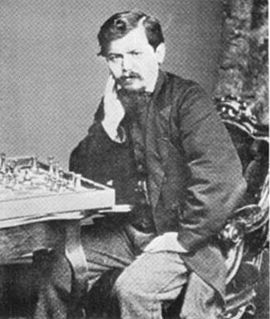Wilhelm Steinitz facts for kids
Quick facts for kids Wilhelm Steinitz |
|
|---|---|
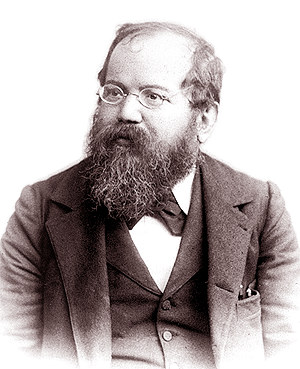 |
|
| Country | Austrian Empire → Austria-Hungary United States |
| Born | May 14, 1836 Prague, Kingdom of Bohemia |
| Died | August 12, 1900 (aged 64) New York City, United States |
| World Champion | 1886–1894 |
William Steinitz (born Wilhelm Steinitz; May 14, 1836 – August 12, 1900) was a famous chess player. He was from Austria and later became an American citizen. From 1886 to 1894, he was the very first official World Chess Champion. He also wrote a lot about chess and developed new ideas for the game.
Some people think Steinitz might have been the world champion even earlier, perhaps starting in 1866. Steinitz lost his title to Emanuel Lasker in 1894. He also lost a rematch against Lasker a few years later.
Even though Steinitz became the world's best player by using an attacking style, he introduced a new way of playing in 1873. This new style focused on "positional play|positional" chess. It meant planning moves to get small advantages over time. This new style was debated a lot, but Steinitz showed it was very strong.
Steinitz wrote many articles about chess. He strongly defended his new ideas. This debate was so intense that it was called the "Ink War." By the early 1890s, most top players accepted Steinitz's ideas. Many, like Emanuel Lasker, said they learned a lot from him.
People used to say Steinitz was short-tempered. But newer research shows he had many long and friendly relationships. He worked with chess groups to set rules for future world championships. Steinitz was not good with money and lived in poverty for most of his life.
Contents
Early Life
Steinitz was born on May 14, 1836. He grew up in the Jewish ghetto of Prague. Prague is now the capital of the Czech Republic. Back then, it was part of the Austrian Empire. He was the youngest of 13 sons. He learned to play chess when he was 12 years old.
He started playing chess seriously in his twenties. This was after he moved to Vienna in 1857. He went there to study mathematics at the Vienna Polytechnic university. Steinitz studied at the university for two years.
Chess Career (1850s to 1881)
Steinitz quickly got better at chess in the late 1850s. He placed third in the 1859 Vienna City championship. Then, he won first place in 1861, scoring 30 out of 31 games. During this time, people called him "the Austrian Morphy." This showed he was the best player in Austria.
First International Games
Steinitz was chosen to play for Austria in the London 1862 chess tournament. He finished sixth in the tournament. However, his win against Augustus Mongredien was so good that it won the "brilliancy prize."
After the tournament, he challenged Serafino Dubois, a strong Italian player. Steinitz won the match. This made him decide to become a professional chess player. He then moved to London. In 1862–63, Steinitz easily won a match against Joseph Henry Blackburne. Blackburne later became one of the world's top ten players for 20 years. Steinitz also beat other top UK players in matches.
Match Against Anderssen
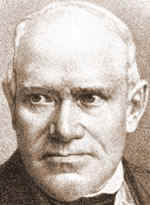
These wins made Steinitz one of the world's best players. In 1866, he played a match in London against Adolf Anderssen. Anderssen was thought to be the strongest active player. This was because he had won big tournaments in 1851 and 1862. The only player better than him, Paul Morphy, had stopped playing chess.
Steinitz won the match with eight wins and six losses. There were no draws. It was a very close fight. After 12 games, the score was tied. Then, Steinitz won the last two games. Because of this victory, Steinitz was generally seen as the world's best player. The winner's prize was £100, which was a lot of money back then.
More Match Wins
After beating Anderssen, Steinitz continued to win matches. He beat Henry Bird in 1866. He also easily beat Johannes Zukertort in 1872. Zukertort had shown he was a top player by beating Anderssen in 1871.
Tournament Success
It took Steinitz longer to win big tournaments. He took third place at Paris 1867. He was second at Dundee (1867) and Baden-Baden 1870 chess tournament. His first big tournament win was London 1872. He finished ahead of Blackburne and Zukertort. Steinitz first finished ahead of Anderssen at the Vienna 1873 chess tournament. Anderssen was 55 years old then.
New Positional Style
Before 1873, Steinitz played in an attacking style. This was common at the time. But at the Vienna 1873 chess tournament, Steinitz showed a new "positional" style. This style focused on small advantages and careful planning. It became the basis of modern chess. He tied for first place and won the play-off. Steinitz won his last 14 games in the tournament. This started a streak of 25 wins in serious games.
Break from Chess
Between 1873 and 1882, Steinitz did not play in many tournaments. He played only one match, which he won easily. During this time, he mostly gave chess lessons and played in special exhibitions. These exhibitions helped professional chess players earn money.
Chess Writer
Steinitz focused on writing about chess. He wrote for The Field, a leading sports magazine in Britain. Some of his writings caused big arguments. These arguments were called the "Ink War." Steinitz wanted to play another match against Zukertort to settle these debates.
Rivalry with Zukertort

Because Steinitz took a long break, some people thought Zukertort should be the world champion. Zukertort had won some important tournaments. Many people felt that only a match between Steinitz and Zukertort could decide who was the true champion.
Comeback and World Champion Title
Steinitz returned to serious chess at the Vienna 1882 chess tournament. This was a very strong tournament. He tied for first place and drew the play-off match.
Visit to the US
Steinitz visited the United States from December 1882 to May 1883. He was welcomed with excitement. He played many exhibition games. He also won several serious matches against American players. He even visited New Orleans, where Paul Morphy lived.
Return to London
In 1883, Steinitz took second place in the very strong London 1883 chess tournament. Zukertort won this tournament. Zukertort's victory again led some people to call him the world champion. Others said a match between Steinitz and Zukertort was needed to decide.
Moves to the United States
In 1883, Steinitz moved to New York City. He lived there for the rest of his life. He started his own magazine, the International Chess Magazine, in 1885. In his magazine, he wrote about the long talks to arrange a match with Zukertort.
First World Championship Match
Finally, in 1886, Steinitz and Zukertort agreed to play a match. It would be held in New York, St. Louis, and New Orleans. The first player to win 10 games would be the victor. Steinitz insisted that the contract say it was "for the Championship of the World."
Zukertort started strong, leading 4–1 after five games. But Steinitz made an amazing comeback. He won the match decisively by 12½–7½. This made him the first official world champion on March 29, 1886. Zukertort won only one of the last 15 games. This was a huge change in fortune.
Steinitz became a US citizen on November 23, 1888. He changed his first name from Wilhelm to William.
Defeats Chigorin
In 1888, the Havana Chess Club offered to host a match. Steinitz chose the Russian player Mikhail Chigorin as his opponent. The match was played in Havana in 1889. Steinitz won with ten wins, one draw, and six losses.
New York 1889 Tournament
A chess group in America wanted the winner of a tournament to be the world champion. Steinitz said he would not play in this tournament. Mikhail Chigorin and Max Weiss tied for first place. But Weiss decided not to play for the title. So, the third-place winner, Isidor Gunsberg, played Steinitz instead. Steinitz won this match in New York in 1890.
Wins Rematch Against Chigorin
In 1891, chess clubs offered to organize another Steinitz–Chigorin match. Steinitz played Chigorin in Havana in 1892. He won a close match.
Loses Title to Lasker
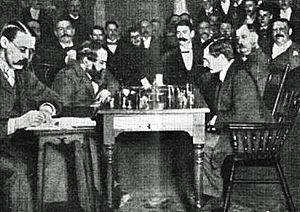
Steinitz thought about retiring. But then Emanuel Lasker challenged him. Lasker was 32 years younger and not as experienced at the top level. Steinitz agreed to play for less money than usual. This was seen as good sportsmanship.
The match was played in 1894 in New York, Philadelphia, and Montreal. Steinitz had said he would win easily. So, it was a surprise when Lasker won the first game. Lasker then won many games in the middle of the match. Steinitz could not recover. Lasker won with ten wins, five losses, and four draws. Some people thought Steinitz lost because he tried "experimental" moves in important games.
More Tournaments
After losing his title, Steinitz played in more tournaments. He won in New York City in 1894. He also placed second at a very strong tournament in Saint Petersburg in 1895. His results started to decline after that.
Rematch with Lasker
In 1896–97, Steinitz played a rematch with Lasker in Moscow. But he lost badly, winning only 2 games. This was the last world chess championship match for 11 years. After the match, Steinitz had a mental breakdown. He spent some time in a hospital in Moscow.
When Did Steinitz Become Champion?

There is a debate about when Steinitz became the World Chess Champion. Some say it was in 1866 when he beat Anderssen. Others say it was in 1886 when he beat Zukertort. In 1894, a chess magazine said Steinitz had been champion for 28 years.
Steinitz himself claimed in the 1880s that he had been champion since his win over Anderssen. However, he might not have claimed the title earlier because Paul Morphy was still alive. Morphy had beaten Anderssen even more easily in 1858. But Morphy stopped playing chess in 1859 and died in 1884.
The 1886 match between Steinitz and Zukertort was the first one officially called "for the World Championship." But people had unofficially called other players "World Chess Champion" before. Some people thought Steinitz was the champion after he beat Zukertort in 1872. In the late 1870s and early 1880s, some supported Steinitz as champion, while others supported Zukertort. The 1886 match helped settle these different claims.
Personal Life
Steinitz lived with Caroline Golder in the 1860s. Their daughter, Flora, was born in 1866. Flora died in 1888 when she was 21. Caroline died in 1892. Steinitz married a second wife a few years later. They had two children together.
In 1897, a newspaper mistakenly reported that Steinitz had died. In the months before his actual death, he spent time in hospitals due to his mental health. He did not earn much money from chess. He died poor in a hospital in New York on August 12, 1900. He had a heart attack. Steinitz is buried in Brooklyn, New York. His second wife and their two young children were still alive when he passed away.
His Impact on Chess
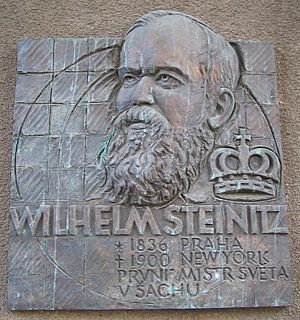
How He Changed the Game
Steinitz's early chess style was aggressive, like other players of his time. This was how he became the world's top player. But in 1873, his playing style changed. He started focusing on "positional" elements in chess. These include things like pawn structure, controlling space, and using knights effectively.
Steinitz often played difficult defensive positions. He did this to show that his new theories were better. But he also showed that his methods could lead to powerful attacks. Emanuel Lasker, who took the championship from Steinitz, described the new style like this: "At the start of the game, don't look for quick attacks. Aim for small advantages. Build them up. Only then, look for a combination to win."
Steinitz wrote a lot about his theories. Many other writers found his new approach hard to understand. Some even called it boring or cowardly. But when he played the first World Championship match in 1886, it was clear Steinitz was playing at a higher level. He often outsmarted his opponent, Zukertort, using his positional ideas.
By the end of his career, Steinitz was more respected for his ideas than just his playing. Lasker said, "He was a thinker worthy of a place in a university. He was not just a player, as the world believed."
Because of his playing and writing, many chess experts see Steinitz, along with Paul Morphy, as the founder of modern chess. Vladimir Kramnik, another world champion, said Steinitz was the first to realize that chess follows certain principles.
His Writings
Steinitz was the main chess writer for The Field magazine from 1873 to 1882. He used this to share his ideas about chess strategy. In 1885, he started his own magazine, the International Chess Magazine, in New York City. He edited it until 1891. He also wrote a textbook called The Modern Chess Instructor in 1889.
Playing Strength and Style
Some computer rating systems rank Steinitz lower than other champions. This is mainly because he took long breaks from playing. However, one analysis showed that Steinitz was one of the most dominant players ever. He was far ahead of his rivals in the 1870s. He also had the third-highest number of years as the world's top player.
Steinitz first played with an aggressive, attacking style. Then he changed to the positional style. He used this style to dominate chess in the 1870s and 1880s. He still kept his ability for brilliant attacks. For example, in a game in 1895, he made a spectacular attack. He deliberately put all his pieces in danger, but still won. His main weaknesses were trying "experimental" moves and getting into difficult defensive positions.
Personality
Some older stories describe Steinitz as having a sharp tongue and a bad temper. He was also very short. He once said, "I always hold the sword in one hand and the olive branch in the other." He could become very harsh in his writings if he felt provoked.
However, his letters and other writings show he had many long and friendly relationships. He worked with many people and groups in the chess world. He even helped the American Chess Congress set rules for future world championship matches.
Steinitz tried to be fair in his writings about chess games. He would praise great play even by his rivals. He could also make fun of himself. For example, he once joked about preferring to lose in America than win in England. He died in poverty in 1900.
Images for kids
-
Adolf Anderssen was seen as the world's best player until 1866. Steinitz beat him in a match that year.
-
Joseph Blackburne. Steinitz beat him 7–0 in 1876.
See also
 In Spanish: Wilhelm Steinitz para niños
In Spanish: Wilhelm Steinitz para niños
- Steinitz Memorial, a blitz chess tournament held from May 15 to May 17, 2020, in honor of Wilhelm Steinitz
- List of Jewish chess players
- Steinitz Variation


